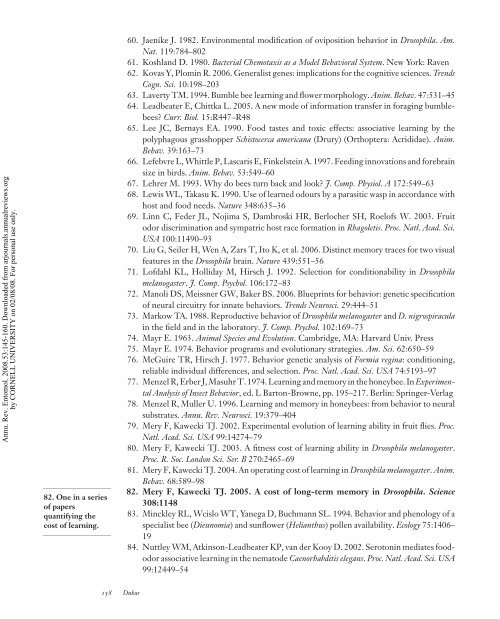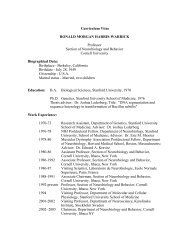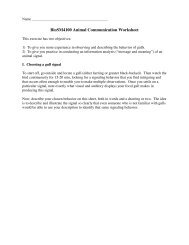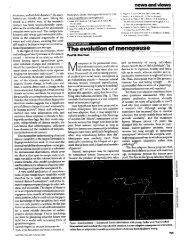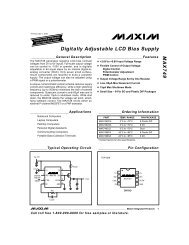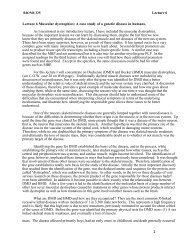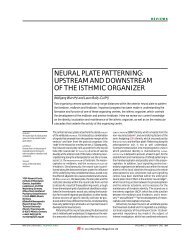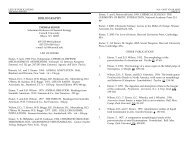Evolutionary Biology of Insect Learning - Department of ...
Evolutionary Biology of Insect Learning - Department of ...
Evolutionary Biology of Insect Learning - Department of ...
You also want an ePaper? Increase the reach of your titles
YUMPU automatically turns print PDFs into web optimized ePapers that Google loves.
Annu. Rev. Entomol. 2008.53:145-160. Downloaded from arjournals.annualreviews.orgby CORNELL UNIVERSITY on 02/08/08. For personal use only.82. One in a series<strong>of</strong> papersquantifying thecost <strong>of</strong> learning.60. Jaenike J. 1982. Environmental modification <strong>of</strong> oviposition behavior in Drosophila. Am.Nat. 119:784–80261. Koshland D. 1980. Bacterial Chemotaxis as a Model Behavioral System. New York: Raven62. Kovas Y, Plomin R. 2006. Generalist genes: implications for the cognitive sciences. TrendsCogn. Sci. 10:198–20363. Laverty TM. 1994. Bumble bee learning and flower morphology. Anim. Behav. 47:531–4564. Leadbeater E, Chittka L. 2005. A new mode <strong>of</strong> information transfer in foraging bumblebees?Curr. Biol. 15:R447–R4865. Lee JC, Bernays EA. 1990. Food tastes and toxic effects: associative learning by thepolyphagous grasshopper Schistocerca americana (Drury) (Orthoptera: Acrididae). Anim.Behav. 39:163–7366. Lefebvre L, Whittle P, Lascaris E, Finkelstein A. 1997. Feeding innovations and forebrainsize in birds. Anim. Behav. 53:549–6067. Lehrer M. 1993. Why do bees turn back and look? J. Comp. Physiol. A 172:549–6368. Lewis WL, Takasu K. 1990. Use <strong>of</strong> learned odours by a parasitic wasp in accordance withhost and food needs. Nature 348:635–3669. Linn C, Feder JL, Nojima S, Dambroski HR, Berlocher SH, Roel<strong>of</strong>s W. 2003. Fruitodor discrimination and sympatric host race formation in Rhagoletis. Proc. Natl. Acad. Sci.USA 100:11490–9370. Liu G, Seiler H, Wen A, Zars T, Ito K, et al. 2006. Distinct memory traces for two visualfeatures in the Drosophila brain. Nature 439:551–5671. L<strong>of</strong>dahl KL, Holliday M, Hirsch J. 1992. Selection for conditionability in Drosophilamelanogaster. J. Comp. Psychol. 106:172–8372. Manoli DS, Meissner GW, Baker BS. 2006. Blueprints for behavior: genetic specification<strong>of</strong> neural circuitry for innate behaviors. Trends Neurosci. 29:444–5173. Markow TA. 1988. Reproductive behavior <strong>of</strong> Drosophila melanogaster and D. nigrospiraculain the field and in the laboratory. J. Comp. Psychol. 102:169–7374. Mayr E. 1963. Animal Species and Evolution. Cambridge, MA: Harvard Univ. Press75. Mayr E. 1974. Behavior programs and evolutionary strategies. Am. Sci. 62:650–5976. McGuire TR, Hirsch J. 1977. Behavior genetic analysis <strong>of</strong> Formia regina: conditioning,reliable individual differences, and selection. Proc. Natl. Acad. Sci. USA 74:5193–9777. Menzel R, Erber J, Masuhr T. 1974. <strong>Learning</strong> and memory in the honeybee. In ExperimentalAnalysis <strong>of</strong> <strong>Insect</strong> Behavior, ed. L Barton-Browne, pp. 195–217. Berlin: Springer-Verlag78. Menzel R, Muller U. 1996. <strong>Learning</strong> and memory in honeybees: from behavior to neuralsubstrates. Annu. Rev. Neurosci. 19:379–40479. Mery F, Kawecki TJ. 2002. Experimental evolution <strong>of</strong> learning ability in fruit flies. Proc.Natl. Acad. Sci. USA 99:14274–7980. Mery F, Kawecki TJ. 2003. A fitness cost <strong>of</strong> learning ability in Drosophila melanogaster.Proc. R. Soc. London Sci. Ser. B 270:2465–6981. Mery F, Kawecki TJ. 2004. An operating cost <strong>of</strong> learning in Drosophila melanogaster. Anim.Behav. 68:589–9882. Mery F, Kawecki TJ. 2005. A cost <strong>of</strong> long-term memory in Drosophila. Science308:114883. Minckley RL, Wcislo WT, Yanega D, Buchmann SL. 1994. Behavior and phenology <strong>of</strong> aspecialist bee (Dieunomia) and sunflower (Helianthus) pollen availability. Ecology 75:1406–1984. Nuttley WM, Atkinson-Leadbeater KP, van der Kooy D. 2002. Serotonin mediates foododorassociative learning in the nematode Caenorhabditis elegans. Proc. Natl. Acad. Sci. USA99:12449–54158 Dukas


